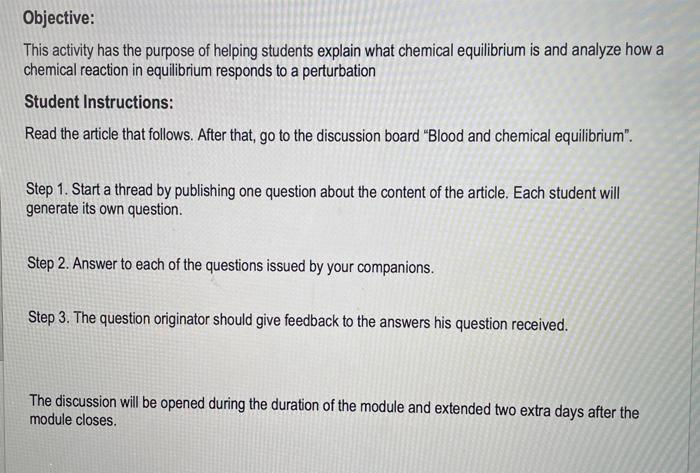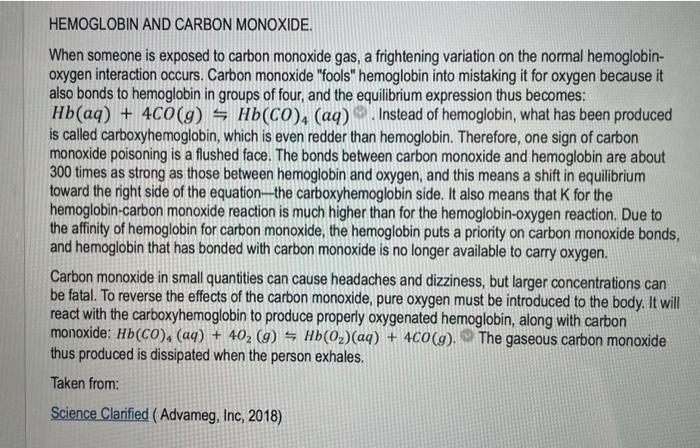This activity has the purpose of helping students explain what chemical equilibrium is and analyze how : chemical reaction in equilibrium responds to a perturbation Student Instructions: Read the article that follows. After that, go to the discussion board "Blood and chemical equilibrium". Step 1. Start a thread by publishing one question about the content of the article. Each student will generate its own question. Step 2. Answer to each of the questions issued by your companions. Step 3. The question originator should give feedback to the answers his question received. The discussion will be opened during the duration of the module and extended two extra days after the module closes. HEMOGLOBIN AND OXYGEN. Hemoglobin, a protein containing iron, is the material in red blood cells responsible for transporting oxygen to the cells. Each hemoglobin molecule attaches to four oxygen atoms, and the equilibrium conditions of the hemoglobin-oxygen interaction can be expressed thus: Hb(aq)+4O2(g)Hb(O2)4(aq). where " Hb " b2, stands for hemoglobin. As long as there is sufficient oxygen in the air, a healthy equilibrium is maintained; but at high altitudes, considerable changes occur. At significant elevations above sea level, the air pressure is lowered, and thus it is more difficult to obtain the oxygen one needs. The result, in accordance with Le Chtelier's principle, is a shift in equilibrium to the left, away from the oxygenated hemoglobin. Without adequate oxygen fed to the body's cells and tissues, a person tends to feel light-headed. When someone not physically prepared for the change is exposed to high altitudes, it may be necessary to introduce pressurized oxygen from an oxygen tank. This shifts the equilibrium to the right. For people born and raised at high altitudes, however, the body's chemistry performs the equilibrium shift-by producing more hemoglobin, which also shifts equilibrium to the right. When someone is exposed to carbon monoxide gas, a frightening variation on the normal hemoglobinoxygen interaction occurs. Carbon monoxide "fools" hemoglobin into mistaking it for oxygen because it also bonds to hemoglobin in groups of four, and the equilibrium expression thus becomes: Hb(aq)+4CO(g)HbCCO)4(aq). Instead of hemoglobin, what has been produced is called carboxyhemoglobin, which is even redder than hemoglobin. Therefore, one sign of carbon monoxide poisoning is a flushed face. The bonds between carbon monoxide and hemoglobin are about 300 times as strong as those between hemoglobin and oxygen, and this means a shift in equilibrium toward the right side of the equation - the carboxyhemoglobin side. It also means that K for the hemoglobin-carbon monoxide reaction is much higher than for the hemoglobin-oxygen reaction. Due to the affinity of hemoglobin for carbon monoxide, the hemoglobin puts a priority on carbon monoxide bonds, and hemoglobin that has bonded with carbon monoxide is no longer available to carry oxygen. Carbon monoxide in small quantities can cause headaches and dizziness, but larger concentrations can be fatal. To reverse the effects of the carbon monoxide, pure oxygen must be introduced to the body. It will react with the carboxyhemoglobin to produce properly oxygenated hemoglobin, along with carbon monoxide: Hb(CO)4(aq)+4O2(g)Hb(O2)(aq)+4CO(g). 7 The gaseous carbon monoxide thus produced is dissipated when the person exhales. Taken from: Science Clarified (Advameg, Inc, 2018)









